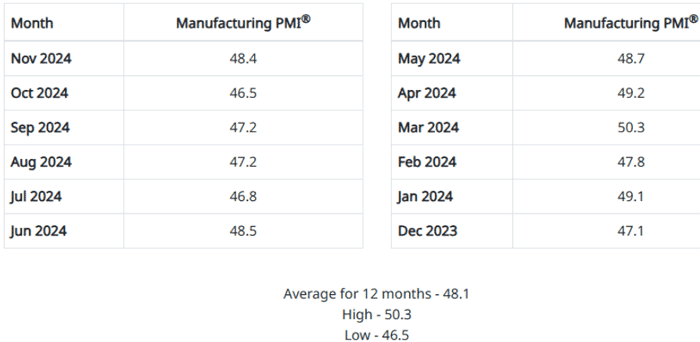The US Purchasing Managers Index (PMI) for November was released Monday by the Institute for Supply Management (ISM), and came in at a level of 48.4, up from 46.5 in October, (the lowest score of the year), but again below the key 50 mark that separates US manufacturing expansion from contraction.
Supply Chain Digest Says... |
 |
|
| Said Timothy Fiore, Chair of the Institute for Supply Management Manufacturing Business Survey Committee: “: “Demand remains weak, as companies prepare plans for 2025 with the benefit of the election cycle ending" |
|
 |
|
What do you say? |
|
| Click here to send us your comments |
|
| |
|
| Click here to see reader feedback |
|
|
|
The US PMI had previously been in contraction territory for 17 straight months until it poked its head into expansion in March of this year, but has fallen back to contraction now in each of the last eight months.
The overall economy continued in expansion for the 55th month after one month of contraction in April 2020. The PMI tracks closely but not exactly with the overall US economy.
A Manufacturing PMI above 42.5, over a period of time, generally indicates an expansion of the overall economy, according to ISM.
The other PMI numbers we track were also mostly negative.
In modest good news, the New Orders Index returned to expansion, albeit weakly, after seven months of contraction, registering a score of 50.4, 3.3 percentage points higher than the 47.1 seen in October.
The November score of the Production Index was 46.8, up slightly from October, but meaning manufacturing output once was in contraction status.
The Prices Index, however, went into expansion territory for the second straight month, registering 50.3, but down 4.5 percentage points compared to the reading of 54.8 in October. That means most companies (barely) saw an increase in the cost of components, materials and other inputs (below 50 = falling prices) in November.
The Backlog of Orders Index came in at just 41.8, down 0.5 percentage point compared to the 42.3 recorded in October. That means the order book of most companies is shrinking, with the index level still well below the 50 mark.
The Supplier Deliveries Index indicated faster deliveries, registering 48.7, 3.3 percentage points lower than the 52.0 recorded in October.
Supplier Deliveries is the only ISM index that is inversed, with a reading of above 50 indicating slower deliveries, which is typical as the economy improves and customer demand increases - or the reverse.
The Inventories Index came in at 48.1, up a strong 5.5 percentage points compared to October, but with the score below 50 indicating inventory levels at companies are decreasing.
Said Timothy Fiore, Chair of the Institute for Supply Management Manufacturing Business Survey Committee: “Demand remains weak, as companies prepare plans for 2025 with the benefit of the election cycle ending. Production execution eased in November, consistent with demand sluggishness and weak backlogs. Suppliers continue to have capacity, with lead times improving but some product shortages reappearing. Sixty-six percent of manufacturing gross domestic product (GDP) contracted in November, up from 63 percent in October.”
(See More Below)
|
CATEGORY SPONSOR: SOFTEON |
|
|
|
|
|
As always, the ISM report provides a graphic of the PMI scores the last 12 months, which as can be seen indicates the measure has been below the key 50 for the past year and actually since November 2022, with the exception of March 2024. It is now averaging just 48.1 over the past year.
US PMI Last 12 Months

Source: ISM
Of the 18 sectors tracked by ISM, just three saw growth in November. Those were, in growth order: Food, Beverage & Tobacco Products; Computer & Electronic Products; and Electrical Equipment, Appliances & Components.
As always, there were some interesting comments from PMI survey respondents.
“Inflation, even after easing, continues to impact demand. Consumers are looking for value, and purchasing behaviors are changing as many shoppers reduce consumption, causing softer volume.” said one manager in the food and beverage sector.
“Business is slowing as customers destock and appear uncertain about near-term demand. Preliminary forecast for 2025 is down significantly; we hope to see improvements now that we are beyond US election uncertainties.” added a respondent in the fabricated metal products industry.
Finally, a manager in the transportation equipment industry observed that “Business remains slow. We anticipate that the first half of 2025 will be similar and hope that demand increases in the second half of 2025.”
What are your thoughts on the November PMI? Let us know your thoughts at the Feedback section below.
Your Comments/Feedback
|

